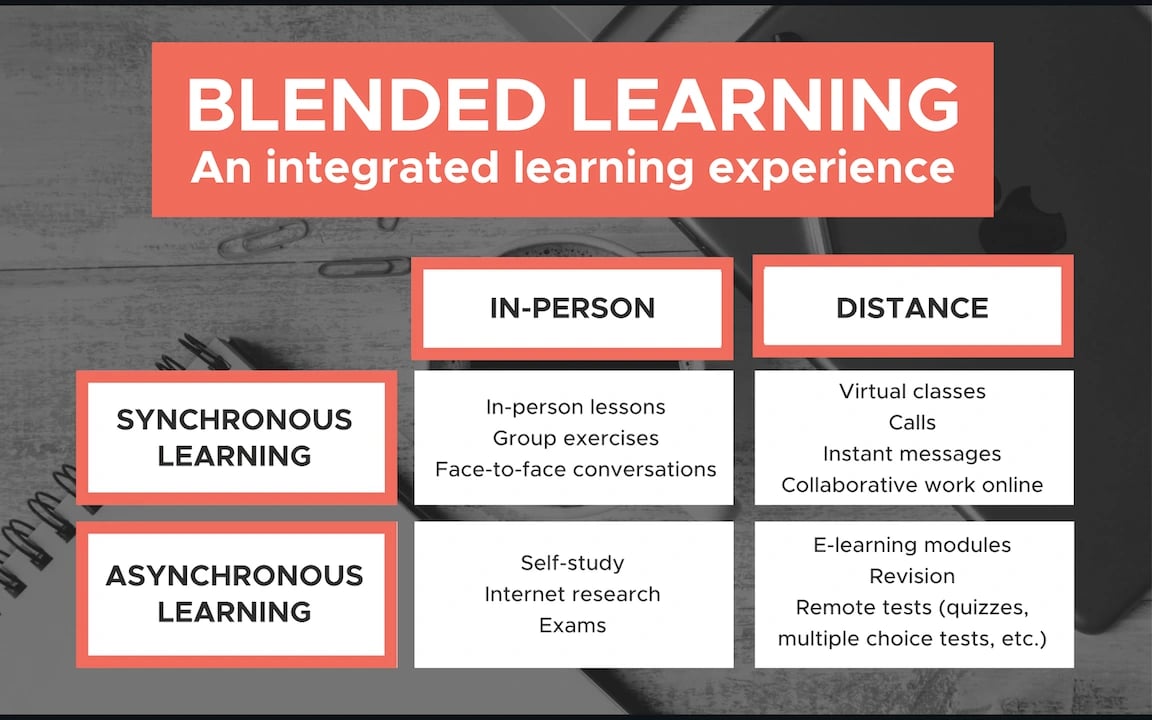7 Minutes of reading
The pros and cons of blended learning
Over the past few years, blended learning has become increasingly popular among trainers and learners – and for good reason. It arguably represents the best of both worlds, drawing on the benefits of both online and in-person training methods, and enables learners to upskill more quickly.

This method is often praised for maximising learner engagement and facilitating access to training. But is it really as great as it seems? And, more importantly, is it a good fit for your organisation? To help you decide, let’s take a look at the pros and cons of blended learning.
The pros
It offers an interactive way to learn
By combining the best aspects of digital and in-person learning, blended learning solves the problems presented by e-learning: it has a lower abandonment rate and sees employees demonstrate greater commitment to their training course.
Given that blended learning alternates between synchronous learning (at the same time and in the same place, either virtually or in person) and asynchronous learning (pre-recorded), it removes the isolation factor from distance learning.
That’s because synchronous learning methods make training courses more engaging by promoting interactions between participants.
What’s more, hybrid training courses retain an element of human contact throughout because they incorporate virtual classes and in-person sessions. They also facilitate group work, workshops and other practical exercises.
Lastly, employees are genuinely supported by their trainer, who not only develops the online training course for learners but tracks their progress from start to finish. The trainer is on hand to answer any questions and can even organise a meeting, either virtual or face to face, to review the learner’s progress.
It’s based on neuroscience
Neuroscience helps us understand how the brain works, as well as how it processes and assimilates information. For that reason, it’s often employed during the development phase of a training course. For example, neuroscience has shown that the brain is more receptive to shorter modules and that participants learn more quickly when there is a blend of methods and formats.
A blended training course is underpinned by teaching objectives, which should correspond to a specific aim and be defined ahead of the design phase.
These objectives are what defines the entire training course and enable the trainer to select appropriate learning tools. Aligning the teaching objectives with the training methods makes for a more impactful and effective blended learning course.
It offers a dynamic learning experience
Gone are the days where learners had to sit through bland and tedious e-learning courses! Nowadays, there are tons of different learning formats and training methods that can inject some life into training courses. And by combining in-person sessions and e-learning modules, blended learning provides learners with a unique training experience.
As a result, employees are more invested in their own learning. They can complete on-line modules at their own pace while remaining motivated by their progress at face-to-face sessions. This gives them a real stake in their own progression – a far cry from the early days of e-learning, where participants were simply passive learners.
It’s also worth noting that it’s not just the job of the trainer to ensure that blended learning courses are dynamic. LMS service providers also have a role to play in adapting their tools to respond to learner needs.
It’s a comprehensive and proven method
With blended learning, employees can benefit from the best of each learning method. In fact, hybrid training is most versatile in the field of professional training. That’s because it allows a combination of in-person/distance learning and synchronous/asynchronous learning.
According to the Digital learning in a post-Covid-19 economy report published in January 2021 by the CIPD, 80% of employers surveyed were planning on increasing the provision of digital and online learning over the next 12 months. Even before the pandemic, large companies were moving towards blended learning and development, with Rolls-Royce stating that it had adopted "a digital-first approach to learning, complemented by classroom-based time and on-the-job coaching and mentoring".
Understandably, as the pandemic has forced us to re-think professional training, hybrid training has grown in popularity. Blended learning enables employees to continue gaining new skills with the aid of e-learning. And the icing on the cake is that, compared with courses which are held purely online, the face-to-face sessions maintain peer interaction.
The cons
Blended learning courses are more time-consuming to design
If a blended learning course is well constructed, it will naturally take a bit longer to design than a course which is purely based on e-learning.
As well as creating the e-learning modules, it involves scheduling all of the in-person sessions (i.e., creating a timetable, finding a room, hiring a trainer, factoring in travel and accommodation costs for employees, etc.).
Above all, to ensure that the blended learning programme is both effective and viable, a company has to invest in instructional design. This involves analysing and creating training schemes based on a range of factors, including neuroscience, learner profiles and the company ecosystem, among others.
A training course embedded in instructional design needs to meet the clearly specified aim established in the initial teaching objectives. This ensures that training courses are truly adapted to the needs of employees. As a result, more employees finish the training, and they develop new skills much more quickly.
You need to use an LMS/LXP capable of supporting blended learning
Launching into blended learning without any experience can quickly lead to problems down the line, particularly if a company has little experience in digital training.
The simpler solution is to use an LMS to take care of the management and administration of in-person sessions and e-learning modules on a single platform. Tools like this make the training process much smoother for both the company and employees.
For example, employees can study for their modules online and, when they need to join a scheduled virtual class, access it without having to exit the LMS platform.
Developers working on learning management systems now make a point of putting learner experience at the heart of the training process with the use of LXP platforms.
However, for all their practicalities, these tools incur fairly substantial expenses from the point of purchase. That said, this investment quickly pays for itself as it enables companies to make long-term savings.
Some learners are reluctant to use digital or blended learning
Not all employees feel the same about technology. Younger generations who have grown up with technology are likely to feel more at ease with a training platform.
However, it’s important to consider the profile of every employee within a company, from those who are willing to use technology as part of the training process to those who are a bit more reluctant.
Rest assured that this is not a reason to completely abandon digital training. In fact, the blended learning platforms available on the market are increasingly seamless and easy to use. A small briefing or training induction should be enough to reassure even the most technophobic of employees!
Download our expert guide: 'learning in the flow of work' to discover more about blended learning and understand how to adopt a learning culture.



